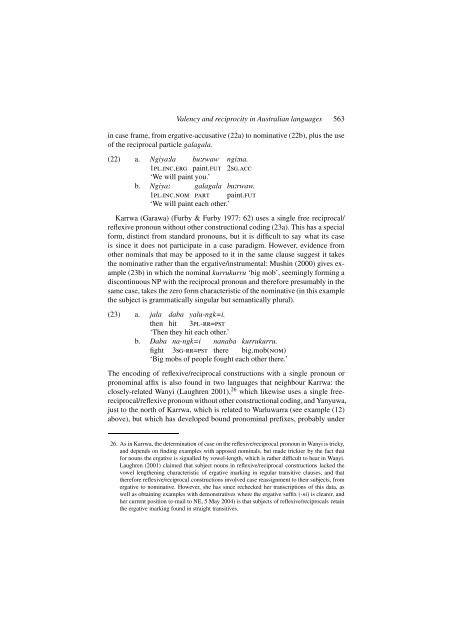Valency mismatches and the coding of reciprocity in ... - Linguistics
Valency mismatches and the coding of reciprocity in ... - Linguistics
Valency mismatches and the coding of reciprocity in ... - Linguistics
You also want an ePaper? Increase the reach of your titles
YUMPU automatically turns print PDFs into web optimized ePapers that Google loves.
<strong>Valency</strong> <strong>and</strong> <strong>reciprocity</strong> <strong>in</strong> Australian languages 563<br />
<strong>in</strong> case frame, from ergative-accusative (22a) to nom<strong>in</strong>ative (22b), plus <strong>the</strong> use<br />
<strong>of</strong> <strong>the</strong> reciprocal particle galagala.<br />
(22) a. Ngiya:la bu:rwaw ngi:na.<br />
1pl.<strong>in</strong>c.erg pa<strong>in</strong>t.fut 2sg.acc<br />
‘We will pa<strong>in</strong>t you.’<br />
b. Ngiya: galagala bu:rwaw.<br />
1pl.<strong>in</strong>c.nom part pa<strong>in</strong>t.fut<br />
‘We will pa<strong>in</strong>t each o<strong>the</strong>r.’<br />
Karrwa (Garawa) (Furby & Furby 1977: 62) uses a s<strong>in</strong>gle free reciprocal/<br />
reflexive pronoun without o<strong>the</strong>r constructional <strong>cod<strong>in</strong>g</strong> (23a). This has a special<br />
form, dist<strong>in</strong>ct from st<strong>and</strong>ard pronouns, but it is difficult to say what its case<br />
is s<strong>in</strong>ce it does not participate <strong>in</strong> a case paradigm. However, evidence from<br />
o<strong>the</strong>r nom<strong>in</strong>als that may be apposed to it <strong>in</strong> <strong>the</strong> same clause suggest it takes<br />
<strong>the</strong> nom<strong>in</strong>ative ra<strong>the</strong>r than <strong>the</strong> ergative/<strong>in</strong>strumental: Mush<strong>in</strong> (2000) gives example<br />
(23b) <strong>in</strong> which <strong>the</strong> nom<strong>in</strong>al kurrukurru ‘big mob’, seem<strong>in</strong>gly form<strong>in</strong>g a<br />
discont<strong>in</strong>uous NP with <strong>the</strong> reciprocal pronoun <strong>and</strong> <strong>the</strong>refore presumably <strong>in</strong> <strong>the</strong><br />
same case, takes <strong>the</strong> zero form characteristic <strong>of</strong> <strong>the</strong> nom<strong>in</strong>ative (<strong>in</strong> this example<br />
<strong>the</strong> subject is grammatically s<strong>in</strong>gular but semantically plural).<br />
(23) a. jala daba yalu-ngk=i.<br />
<strong>the</strong>n hit 3pl-rr=pst<br />
‘Then <strong>the</strong>y hit each o<strong>the</strong>r.’<br />
b. Daba na-ngk=i nanaba kurrukurru.<br />
fight 3sg-rr=pst <strong>the</strong>re big.mob(nom)<br />
‘Big mobs <strong>of</strong> people fought each o<strong>the</strong>r <strong>the</strong>re.’<br />
The en<strong>cod<strong>in</strong>g</strong> <strong>of</strong> reflexive/reciprocal constructions with a s<strong>in</strong>gle pronoun or<br />
pronom<strong>in</strong>al affix is also found <strong>in</strong> two languages that neighbour Karrwa: <strong>the</strong><br />
closely-related Wanyi (Laughren 2001), 26 which likewise uses a s<strong>in</strong>gle freereciprocal/reflexive<br />
pronoun without o<strong>the</strong>r constructional <strong>cod<strong>in</strong>g</strong>, <strong>and</strong> Yanyuwa,<br />
just to <strong>the</strong> north <strong>of</strong> Karrwa, which is related to Warluwarra (see example (12)<br />
above), but which has developed bound pronom<strong>in</strong>al prefixes, probably under<br />
26. As <strong>in</strong> Karrwa, <strong>the</strong> determ<strong>in</strong>ation <strong>of</strong> case on <strong>the</strong> reflexive/reciprocal pronoun <strong>in</strong> Wanyi is tricky,<br />
<strong>and</strong> depends on f<strong>in</strong>d<strong>in</strong>g examples with apposed nom<strong>in</strong>als, but made trickier by <strong>the</strong> fact that<br />
for nouns <strong>the</strong> ergative is signalled by vowel-length, which is ra<strong>the</strong>r difficult to hear <strong>in</strong> Wanyi.<br />
Laughren (2001) claimed that subject nouns <strong>in</strong> reflexive/reciprocal constructions lacked <strong>the</strong><br />
vowel leng<strong>the</strong>n<strong>in</strong>g characteristic <strong>of</strong> ergative mark<strong>in</strong>g <strong>in</strong> regular transitive clauses, <strong>and</strong> that<br />
<strong>the</strong>refore reflexive/reciprocal constructions <strong>in</strong>volved case reassignment to <strong>the</strong>ir subjects, from<br />
ergative to nom<strong>in</strong>ative. However, she has s<strong>in</strong>ce rechecked her transcriptions <strong>of</strong> this data, as<br />
well as obta<strong>in</strong><strong>in</strong>g examples with demonstratives where <strong>the</strong> ergative suffix (-ni) is clearer, <strong>and</strong><br />
her current position (e-mail to NE, 5 May 2004) is that subjects <strong>of</strong> reflexive/reciprocals reta<strong>in</strong><br />
<strong>the</strong> ergative mark<strong>in</strong>g found <strong>in</strong> straight transitives.

















